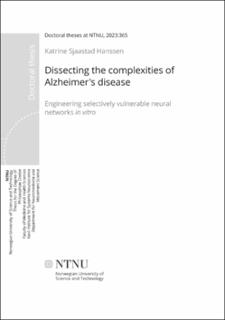| dc.contributor.advisor | Kobro-Flatmoen, Asgeir | |
| dc.contributor.advisor | Sandvig, Ioanna | |
| dc.contributor.advisor | Witter, Menno | |
| dc.contributor.author | Hanssen, Katrine Sjaastad | |
| dc.date.accessioned | 2023-11-13T15:15:30Z | |
| dc.date.available | 2023-11-13T15:15:30Z | |
| dc.date.issued | 2023 | |
| dc.identifier.isbn | 978-82-326-7429-9 | |
| dc.identifier.issn | 2703-8084 | |
| dc.identifier.uri | https://hdl.handle.net/11250/3102246 | |
| dc.description | Kavli Institute for Systems Neuroscience and
Department for Neuromedicine and Movement Science | en_US |
| dc.description.abstract | Alzheimer’s disease (AD) is a progressive, neurodegenerative disease where accumulation of neuropathology can start up to two decades before symptom onset. With no cure for the disease, relevant models of AD are needed to better understand initial disease cascades. Transgenic AD animal models and cell culture models have been crucial in the study of AD, and have contributed to a better understanding of neuropathology, disease progression and altered network activity. Applying basic research strategies is crucial before testing new therapeutics to translate the efficacy of potential treatments to the clinic. In vitro modelling of AD introduces a reductionist approach for investigating the disease at the cellular and molecular level. Such models can be particularly useful for studying the early stages of AD, as they allow for the analysis of neural network dynamics. The harvest and in vitro culturing of adult primary neurons from AD animal models is an elegant way to model early phases of AD as the neurons retain their epigenetic profile and age-effects as in the living animal.
In this thesis, the overarching aim has been to develop new methods for modelling of AD by the use of cell cultures. In the first paper we present a method to dissect and longitudinally culture adult layer specific lateral entorhinal cortex layer II (LECLII) neurons from AD transgenic APP/PS1 model mice. Furthermore, in addition to LEC LII, we dissected hippocampal subregional DG, CA3 and CA1 neurons from adult AD transgenic mice and rats and cultured these on four-nodal microfluidic devices (Paper II). We show that adult neurons dissected from rodent AD models re-form structural connections and display sustained electrophysiological activity. By use of commercially available cortical-hippocampal neurons we show the utility of microfluidic devices ensuring feedforward connectivity with emergence of complex structure-function dynamics in our networks (Paper II). In the third paper we used twonodal microfluidic devices to study changes in structure-function neural network dynamics on networks perturbed with viral vector delivery of mutated tau protein (Paper III).
Altogether, work in this thesis presents an in vitro modelling system relevant for preclinical disease modelling. We provide novel results through the establishment of layer and subregion specific entorhinal and hippocampal neuron cultures dissected from adult transgenic AD model animals. As technology advances, these models will become increasingly sophisticated and realistic, allowing for more accurate and comprehensive investigations into the complex pathology of AD. | en_US |
| dc.language.iso | eng | en_US |
| dc.publisher | NTNU | en_US |
| dc.relation.ispartofseries | Doctoral theses at NTNU;2023:365 | |
| dc.relation.haspart | Paper 1: Hanssen, Katrine Sjaastad; Witter, Menno Peter; Sandvig, Axel; Sandvig, Ioanna; Kobro-Flatmoen, Asgeir. Dissection and culturing of adult lateral entorhinal cortex layer II neurons from APP/PS1 Alzheimer model mice. Journal of Neuroscience Methods 2023 ;Volume 390. https://doi.org/10.1016/j.jneumeth.2023.109840 | en_US |
| dc.relation.haspart | Paper 2: Hanssen, Katrine Sjaastad; Winter-Hjelm, Nicolai; Niethammer, Salome Nora; Kobro-Flatmoen, Asgeir; Witter, Menno Peter; Sandvig, Axel; Sandvig, Ioanna. Reverse Engineering of Feedforward Cortical-Hippocampal Neural Networks Relevant for Preclinical Disease Modelling. bioRxiv 2023 - preprint https://doi.org/10.1101/2023.06.26.546556 - The copyright holder for this preprint (which was not certified by peer review) is the author/funder. All rights reserved. No reuse allowed without permission. | en_US |
| dc.relation.haspart | Paper 3:
Weur, Janelle S; Hanssen, Katrine Sjaastad; Winter-Hjelm, Nicolai; Sandvig, Axel; Ioanna, Sandvig.
Altered structural organization and functional connectivity in feedforward neural networks after induced perturbation. bioRxiv 2023 - preprint
https://doi.org/10.1101/2023.09.12.557339
- The copyright holder for this preprint (which was not certified by peer review) is the author/funder. All rights reserved. No reuse allowed without permission. | en_US |
| dc.title | Dissecting the complexities of Alzheimer's disease: Engineering selectively vulnerable neural networks in vitro | en_US |
| dc.type | Doctoral thesis | en_US |
| dc.subject.nsi | VDP::Medical disciplines: 700 | en_US |
